 Bitcoin is tipped to extend losses this week as investors shy away from risk assets amid a reassessment of the pace and magnitude at which the US Federal Reserve is set to tighten policy.
Bitcoin is tipped to extend losses this week as investors shy away from risk assets amid a reassessment of the pace and magnitude at which the US Federal Reserve is set to tighten policy.
The largest cryptocurrency slid as much as 2% on Monday to US$38 709, extending declines from last month’s high to 20%. The second biggest coin, ether, fell for a sixth day, losing as much as 3.4% to $2 842.
Price charts are signalling further declines, technical analysts say. Bitcoin has dropped below its Ichimoku cloud support on a weekly chart, with secondary support only coming in around $27 200, said Katie Stockton, founder and managing partner at Fairlead Strategies.
She isn’t alone in seeing more downside.
“Bitcoin looks to be breaking a pivotal minor two-month trend on Friday’s pullback that likely causes weakness down to test January lows,” Mark Newton, a technical strategist at Fundstrat, wrote in a research note on Friday. He expects an initial pullback to $36 300, “but breaks of that level should lead to a full retest of $32 950 without too much trouble”.
For all its recent losses, bitcoin remains in the middle of a trading range that has held since the start of the year, between about $35 000 to $45 000. The digital currency moves strongly in line with the tech-heavy Nasdaq 100, and is negatively correlated with the dollar.
With the US central bank expected to hike rates in 50 basis-point steps in coming months to combat inflation, some of the factors that fuelled cryptocurrencies’ stellar gains in the past couple of years are going into reverse.
“As it becomes more valuable to hold dollars, some investors may reallocate from bitcoin or gold to the dollar,” a team from Nydig wrote in a report Friday. “Like the negative correlation of bitcoin to the dollar, the negative correlation of bitcoin to real rates has only emerged in the last couple of years.”
Bitcoin will still be mainly driven by fundamental factors, such as user growth and network usage, but it’s important to understand the evolving macro relationships, they said. — (c) 2022 Bloomberg LP




